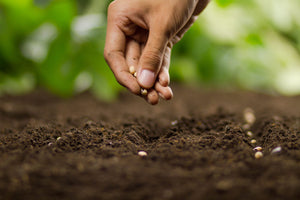Feed Your Community: How and Where to Donate Garden Fresh Produce
DonatingGrowing a garden is not just about enjoying fresh, home-grown produce; it can also be an excellent opportunity to give back to your community. At Sow Right Seeds, we believe in the power of gardening to bring people together and make a positive impact.

Gardeners know how delicious ripe fruits and vegetables are. Sharing that incredible flavor with others is part of the joy of gardening. And yet, according to ampleharvest.org, 11.5 billion pounds of garden produce is wasted every year. But it doesn’t have to be that way. Donating fresh produce can be easy and rewarding.
To some, fresh produce is a luxury home gardeners can easily take for granted. If you find yourself with an abundance of produce this season, consider donating your extras to local organizations that provide food to those in need. By doing so, you can help ensure that fresh, nutritious food reaches individuals and families who might otherwise go without.
Connecting with the right people is the place to start when you have an abundance of fresh garden produce.

Where to Donate Garden Produce
The larger food banks can be a starting point if they are linked to local food pantries where food is distributed. Focusing on local organizations is the most effective way to donate your surplus garden produce. If you have a church food pantry or a senior center, these are often the most convenient ways to donate your garden produce.
This list of places to contact will help to expand your reach.
1. Soup Kitchens and Shelters
These organizations often welcome fresh produce donations to help prepare meals for their clients. They may be the right match for your abundance of fresh herbs.
2. Local Food Pantries
You may have thought you could only donate non-perishable items. While that is true for large food banks that store and distribute food, small local food pantries deal with immediate and often critical needs. Local community centers and churches frequently operate small food pantries serving those in your neighborhood.
3. Community Gardens
Some community gardens have donation programs where excess produce is given to local charities or those in need. These gardens may serve specific areas or populations, and your home garden can contribute to their focus.
4. Farmers Markets
Some farmers' markets have programs where you can donate fresh produce to be distributed to those in need. Stop by your local farmers market and see if they already have a program or if you could help start one.
5. Senior Centers and Meal Programs
Some programs that provide meals to seniors or other vulnerable populations accept fresh produce donations.
6. AmpleHarvest.org
Ampleharvest.org is a free nationwide registry that connects gardeners with local food pantries that accept fresh produce. With almost 9,000 organizations across all 50 states, you can search their website for a pantry near you.

How to Donate Garden Produce
Contact your local food pantry.
Find a place in your neighborhood that accepts donations of fresh garden produce. Before donating, contact the organization to confirm that they can accept fresh produce and to find out any specific requirements they may have.
Find out when and where they accept donations.
Many food banks are open only one day a week or have specific times for accepting donations. Make sure you have the specifics so you can deliver your produce at the right time.
Coordinate with other gardeners.
You may only have a few cucumbers this week, but combining your harvest with your neighbor’s will increase your impact. Spreading the word will also help boost donations.
Plan Your Harvest
If possible, pick produce on the day you donate. Clean dirt off and only donate produce that isn’t rotting. It needs to be fit for human consumption. If you wouldn’t eat it, don’t donate it. Keep produce at a temperature that keeps it fresh for delivery.
Deliver Your Produce
Separate your produce in boxes or bags that keep them fresh and protect them from being damaged. You can also label what it is since herbs suchy as parsley and cilantro often need clarification. Also, an heirloom tomato or ground cherry might need an introduction. Fresh Food Connect has printable donation tags.
Note for Large Farms:
For farmers and those with a large harvest, consider having a gleaning organization come and collect your produce. The gleaners will then distribute the food to those in need.

Many local food pantries, community centers, and organizations such as AmpleHarvest.org are eager to receive fresh, home-grown fruits and vegetables. These donations can make a significant difference in the diets of those facing food insecurity.
Search online or contact local community resources to find the best places to donate. Your generosity can help nourish your community and reduce food waste at the same time.
To make an even greater impact, consider planting an extra row or two in your garden specifically for donation. By dedicating a portion of your garden to growing food for others, you can regularly contribute to local food banks, shelters, and other charitable organizations. This small effort on your part can provide consistent support to those in need and spread the joy of fresh produce throughout your community. For ideas on what to grow, read about the most requested items.
Together, we can cultivate not only our gardens but also a spirit of giving and community support. Sow Right Seeds encourages all gardeners to embrace the opportunity to donate extra produce and plant with purpose. Your contributions can help build a healthier, more connected community, one garden at a time.





Leave a comment